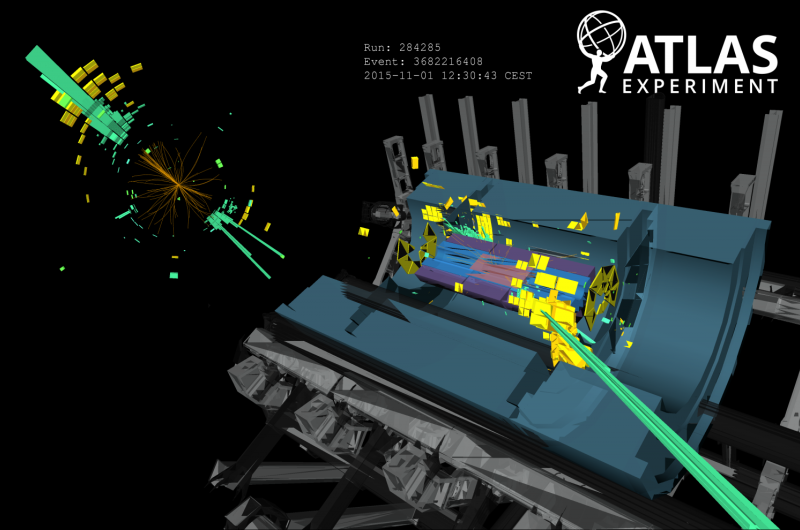On top of the top quark—new ATLAS experiment results

Physicists from the ATLAS Experiment at CERN have presented exciting new results at the 10th International Workshop on Top Quark Physics (TOP2017), held in Braga (Portugal). The conference brought together experimental and theoretical physicists specialising in the heaviest known elementary particle: the top quark.
ATLAS released six new results for TOP2017, covering all areas of top quark physics, including precision measurements in a top-quark pair and single top-quark events, searches for new couplings of the top quark, and measurements of the properties of the top quark, in particular its mass.
Single or Double?
Top quarks in LHC proton-proton collisions are predominantly produced in pairs, with one top quark and one top antiquark. ATLAS presented the first top quark pair cross-section measurements as a function of several variables describing the kinematic properties of the interaction and of the individual top quarks ("differential" measurements). These measurements used events that contain only jets, and no charged leptons or neutrinos. Normally, such events would be overwhelmed by other, more mundane and much more abundant processes, such as strong interactions involving the production of gluons or lighter quarks. However, by focusing on energetic jets inside of which the decay products of the top quark reside, the new ATLAS result achieves the best precision yet for this final state.
Single top quarks produced through the weak interaction are also difficult to identify, especially when the top quark is produced in association with a W boson (tW), which suffers from very large backgrounds from top quark pair production. Despite these experimental challenges, the ATLAS collaboration released the first differential cross-section measurement of tW production, using the full dataset collected in 2015 and 2016. The measurement is in general agreement with several predictions, however it shows that the data tend to have slightly more events with high-momentum final-state objects.
The heaviest of all
Although the top quark was discovered over 30 years ago, many of its properties are only recently being measured with high precision. Key to any study is the top quark mass, which provides crucial information used to assess the internal consistency of the Standard Model and even has implications for the fate of the universe.
Experiments face many challenges when measuring the top quark mass with high precision. Identifying its multiple decay products requires precision measurements in all parts of the ATLAS detector; exquisite modelling of the top-producing collision event and its subsequent evolution is also essential.
A new ATLAS measurement of the top quark mass studied about 36,000 top quark pair events recorded in 2012 and measured the top quark mass with a precision of ±0.91 GeV. When this measurement is combined with other ATLAS top quark mass measurements, the precision reaches ±0.5 GeV, or 0.3%, which rivals with the best combined results from other experiments.
Moving the top forward
The top quark is also a unique laboratory to study the colour aspect of strong interactions. "Colour" designates the charge of the strong interaction. ATLAS presented measurements sensitive to this colour structure by looking at the degree to which two jets are oriented towards each other. Another observable, the so-called top quark charge asymmetry (how much the top quark is aligned with the beam direction compared to the top antiquark) is also very useful for testing subtle features of the strong interaction and could reveal the presence of physics beyond the Standard Model.
ATLAS combined its measurements of top charge asymmetry with those of the CMS collaboration to shrink the uncertainties and obtain a result that is more precise than any previous measurement. This is the first joint ATLAS-CMS publication related to top quark physics and is emblematic of the cooperative nature of high-energy physics also emphasised at TOP2017.
Never – almost?
The top quark is also a unique tool to directly search for new physics extensions of the Standard Model. The decay of the top quark to a Z boson and a light quark through a so-called flavour-changing neutral current (FCNC), which is forbidden in the Standard Model, is predicted by theories like supersymmetry or extra dimensions. Using the 13 TeV dataset collected in 2015 and 2016, no FCNC interactions have been found, and ATLAS has set the most stringent limits to date on this process.
All of these exciting new results pave the way to further detailed studies of the top quark with the larger datasets expected from the LHC in Run 2 and beyond. The ATLAS collaboration looks forward to continued fruitful discussions between theorists and experimentalists about its measurements.
More information: Find out more: atlas.cern/
Provided by ATLAS Experiment




















